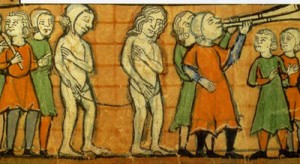By Dr Gwen Seabourne, Reader in Law (University of Bristol Law School).

For centuries, English common law saw married women as inferior to their husbands, disadvantaged in terms of legal rights and to be protected from themselves and from the outside world. Most formal legal disadvantages have been removed, so it might well be asked why modern lawyers should bother to look at the old laws.
One insight from history which is important for those working to consolidate gains already made and to make further improvements in the legal position of women is that there has been no straightforward, as-the-crow-flies, journey from oppressive medieval rules to enlightened modern ones. This comes out particularly in my recent work on the laws about adulterous wives [see G Seabourne, ‘Copulative complexities: the exception of adultery in medieval dower actions‘, in M Dyson and D Ibbetson (eds) Law and Legal Process: : substantive law and procedure in English Legal History (Cambridge, 2013), 34-55; and ibid, ‘Coke, the statute, wives and lovers: routes to a harsher interpretation of the statute of Westminster II (1285) c. 34’ (2014) 34(1) Legal Studies 123-42].
In 1285, a statute barred widows who had previously left their husbands for other men from claiming dower (the right to land to live on during their widowhood). This law survived until 1925, but it underwent important changes. These changes were not, as one might have imagined, in favour of widows: in fact, the law seems to have been interpreted rather more generously to women in the medieval period than it was in later times. A widow who had left her husband as a result of mistreatment fared better before medieval courts than their Victorian equivalents. In Lyndeseye v Ralph son of William (1307), the widow was successful in arguing that she should not be disqualified from dower (even if she had ended up living with another man) because her husband had forced her to leave: in Woodward v Dowse (1861), a similar argument failed.
This contrast shows how the legal position of women could deteriorate even in a common law system supposedly working by precedent, and even in a period usually characterised as one of more positive legislative changes for women (in relation to divorce, property and child custody).
An interesting parallel to this work on property consequences of women’s adultery comes from Krista Kesselring’s study, showing that criminal law also became more unfavourable to adulterous wives in the Victorian period [see K J Kesselring, ‘No greater provocation? Adultery and mitigation of murder in English law’ (2016) 34(1) Law and History Review 199-225]. While a husband who killed his adulterous wife was previously regarded as a murderer, his wife’s adultery came to be seen as at least a partial defence from the mid-nineteenth century.
Apart from showing that Victorian courts had a particular horror of adultery, all of this confirms that there is more to the legal history of women (adulterous or not) than either a tale of progress or a static ‘Horrible Legal History’, to be contrasted with a more enlightened present.
